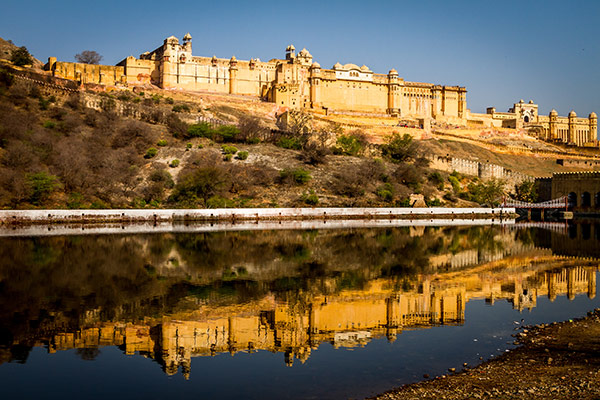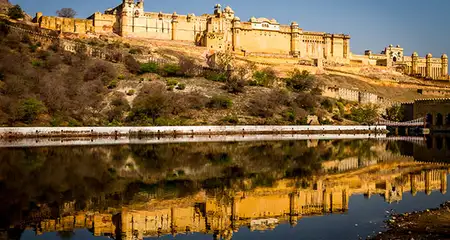Located on the mighty Aravalli Range, Nahargarh Fort offers spectacular views of the city of Jaipur. Once upon a time, the fort was part of the city’s three-point defence strategy, which included the Amer Fort and the Jaigarh Fort as well. Today, this imposing structure is a prime attraction for the travellers visiting the city, thanks to its glorious past of almost 300 years and its vantage position. Are you fascinated? Include this fort in your itinerary when you step out of your hotels in Jaipur to explore the many magnificent marvels dotting the Pink City of India.
In this blog, we have compiled all the details you should know about the Nahargarh Fort in Jaipur, including its history, architecture, timings, entry fee, wax museum, and other visitor info and lesser-known facts.
Nahargarh Fort Information:
| Location | Brahmpuri, Jaipur |
| Timings | 10:00 am to 5:30 pm; every day |
| Entry Fee | ₹ 50 for Indians; ₹ 25 for students; ₹ 200 for foreigners |
| Built-in | 1734 |
| Commissioned by | Maharaja Sawai Jai Singh II |
| Architectural style | Indo-European architecture |
| Restaurants at Nahargarh Fort | Padao, Once Upon A time |
| Key Structure | Madhavendra Bhawan was built by Sawai Madho Singh |
Nahargarh Fort: History
Nahargarh Fort was built in 1734 by the then Maharaja of Jaipur, Sawai Jai Singh II. He constructed the fort as a retreat for the hunting expeditions of the royal family. The fort was initially named Sudarshangarh but was later renamed as Nahargarh. According to local legends, the construction of the fort was obstructed by the spirit of a Rathore prince named Nahar Singh Bhomia. To pacify the spirit, a temple was built in his memory within the premises and the fort was renamed to honor him.
The massive fortification walls of this fort extended to reach up to the Jaigarh Fort, which formed a wall of defence around the city of Jaipur. Throughout its history, this fort never faced any attack. However, it has remained witness to several significant events in the past that took place within its premises, including the signing of truces with the Maratha armies in the 18th century. During India’s first rebellion for freedom in 1857, the king of Jaipur relocated the Europeans living in that region within the walls of the fort.
In 1868, the fort was renovated and extended by Sawai Ram Singh, the then-king of Jaipur. During the period from 1883 to 1892, several palaces were added to the fort at a huge cost of around 3, 50,000 rupees. Separate suites were built within the fort for the royal women and the king. Till 1944, the Jaipur State Government used to fire a gunshot from this fort as a time signal for the whole city.
Explore: 11 Top Historical Places in Jaipur
Nahargarh Fort Architecture
Nahargarh Fort, one of the top tourist places to visit in Jaipur, is designed in the Indo-European style of architecture. The fort features an imposing entrance, called Tadigate, and houses several impressive structures within its premises. There are a couple of temples inside the fort complex, including one dedicated to Nahar Singh Bhomia and another one dedicated to the rulers of Jaipur. The undulating walls of the fort are extended over several kilometres.
Madhavendra Bhawan aka Madhavendra Palace is the most attractive structure within the fort. Constructed by Sawai Madho Singh, this two-storied palace compound comprises of separate living quarters for the king and his queens. There are nine identical suites built for each of the nine queens, each of which is adorned with bedrooms, a lobby, a kitchen, and other essential sections. All these suites were connected through corridors adorned with stunning frescos, but they were built in such a manner that the king could visit any one of his queens without the knowledge of the other queens. The building also includes a large open-air enclosure called Diwan-i-Aam, where the king held an audience with his subjects and attended to their grievances.
There are also two-step wells at Nahargarh Fort, one located within it and one within the ramparts. Of these, the biggest is the one outside the fort and it has also been featured in Bollywood movies. A distinguishing feature of these wells is that, unlike most other step wells in India, they feature an asymmetrical design. This is primarily because these wells are constructed without altering the natural terrain of the mountains.
Nahargarh Fort: Today
Today, Nahargarh Fort stands as one of the amazing forts in Jaipur that narrate the saga of the city’s glorious past. It is also a great place to enjoy mesmerizing sunset views over the city of Jaipur. If you are a shutterbug, you will find lots of opportunities to click the sun-bathed city of Jaipur in hues of orange from the vantage position of the fort.
Madhavendra Palace at the fort is currently converted into an annual sculpture gallery aka the Sculpture Park where the artworks of many contemporary artists are displayed. You can also visit the Jaipur wax museum, which is situated right at the entrance of this fort and is a great tourist attraction.
YOU ALSO LIKE: Things to Do in Jaipur at Night
Jaipur Wax Museum and Sheesh Mahal at Nahargarh Fort
A visit to the Jaipur Wax Museum at Nahargarh Fort is counted among the best things to do in Jaipur. Inaugurated in December 2016 by Bollywood actor Govinda, this museum features over 35 wax statues of personalities belonging to various fields, such as Bollywood, politics, sports, freedom fighters, social activities, and the Jaipur royal family. This includes celebrities from Sachin Tendulkar to Amitabh Bachchan and from Mahatma Gandhi to Deepika Padukone.
A one-of-its-kind section of this museum is Sheesh Mahal or the Palace of Mirrors created using more than 2.5 million pieces of glass in different colors such as blue, green, yellow, and red. This hall brings alive the opulence of the Rajputana era in a unique manner. The interiors of Sheesh Mahal feature floral motifs, ornate chandeliers, and handmade paintings.
- Museum Timings: 10:00 am to 6:30 pm; every day
- Museum Entry Fee: ₹ 500 for Indians; ₹ 700 for foreigners
Lesser-known Facts about Nahargarh Fort
- Nahargarh Fort has been the location of several blockbuster Bollywood movies like Rang De Basanti starring Aamir Khan and Shuddh Desi Romance starring Sushant Singh Rajput and Parineeti Chopra.
- The fort also featured in Sonar Kella, the 1971 Bengali thriller by the renowned filmmaker Satyajit Ray.
- There is another story linked to how the fort got its name. Many believe that at the time of its construction, the fort was home to tigers and that’s why it was named Nahargarh which means the ‘abode of tigers.
Explore: City Palace in Jaipur
Restaurants at Nahargarh Fort
Currently, two restaurants are operating within the Nahargarh Fort complex. Even though entry to the fort closes by evening, you can enjoy a sumptuous dinner at these restaurants till late in the night, enjoying spectacular night views of Jaipur. Both these restaurants serve alcoholic beverages as well. The restaurants at Nahargarh Fort are:
- Once Upon A Time
- Timings: 11:00 am to 11:00 pm; every day
- Approx. cost for two: ₹ 3000
- Padao (operated by RTDC)
- Timings: 10:00 am to 10:00 pm; every day
- Approx. cost for two: ₹ 1000
Attractions near Nahargarh Fort
- Jaigarh Fort (6.3 km)
- Jal Mahal (10.3 km)
- Amber Fort (10.9 km)
Nahargarh Fort may not boast of massive size, but it has a lot of intriguing features that can keep you enthralled for hours. At the same time, the incredible location of the fort makes it an ideal spot for travellers to escape from the hustle and bustle of city life and spend some quiet moments. So, go ahead and explore this fascinating fort in Jaipur.




























